Optimizing operation performance with digital ecosystem
Drilling is a complex process that involves numerous actions and parameters. Historically, the analysis of drilling operations relied on records from individual wells. However, this process presented significant challenges in extracting usable information from job logs, excel sheets and reports. This approach proved to be extraordinarily complex and demanding in terms of human labor. Moreover, the accessibility of data and the presence of human error further compounded the difficulty of gathering and filtering raw data and transforming it into meaningful insights and ultimately impacting decision-making.
DATA ANALITICS
With the advent of Natural Language Processing, it is now possible to extract large datasets from complex job logs and reports and process them into well-organized, high-quality data. By analyzing these historical data, it is possible to identify common drilling problems such as borehole instability, differential sticking, kicks, lost circulation and more. These valuable inputs have proven to be extremely useful for identifying problems and making predictions.
In recent years, the industry has turned to data analytics to identify historical drilling problems and make predictions for new wells within the same region. Additionally, the development of digital twin technology has provided real-time monitoring and better visualization above and below ground for single or multiple wells. The integration of these two technologies has proven to be highly beneficial resulting in significant time and cost savings.
Using 3D models of the rigs, historical well data and Geographic Information System, we are able to generate a virtual copy of a region that is currently under development. Wells, trajectories and spacing can be displayed visually providing the user with a clear view and an instant grasp of the current situation. More importantly, by accessing historical well data, we can identify, categorize and label problems which have occurred in previous drilling process, which allows the user to quickly see the problems and identify a trend and pattern with ease.
CASE STUDY
An analysis was performed by an operator based in China, which has drilled numerous wells in the southwestern shale region. The primary objective was to investigate the potential benefits of data analytics in combination with smart equipment and digital twin in minimizing or even preventing mud loss while drilling through a challenging vertical section that contains a troublesome formation, Fig. 1. To achieve this, the study relied on a wealth of historical drilling and lithology data. The analysis identified a trouble zone that extends between formation A and B, with a thickness range of 1,640-2,296 ft and was characterized by the presence of microfractures.
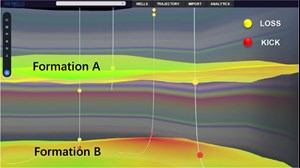
Analysis of previous drilling activities within this formation revealed the repeated occurrence of mud loss scenarios when using mud weight of 1.86 specific gravity (sg). The rate of loss during these instances varied from 0.13 to 0.19 barrels per minute, resulting in a substantial cost increase due to the loss of drilling mud. The recorded mud losses per well ranged from 1,900 barrels (bbl) up to a staggering 4,000 bbl. It was discovered that stopping drilling operations and adjusting the mud weight to 1.76 sg did not yield any meaningful remediation effects. In fact, reducing the mud weight further posed an increased risk to well control.
Additionally, the traditional approach of pumping down lost circulation materials proved to be time-consuming, leading to longer non-productive time (NPT) and escalated costs. Furthermore, these measures had minimal to no effect on bridging the microfractures encountered within the formation. If appropriate preventive and remedial measures are not implemented, drilling a new well within this formation will inevitably result in varying degrees of mud loss.
Modeling identifies potential trouble zones. Despite these challenges, the operator successfully implemented cost-effective solutions to maintain a normal drilling process and avert mud loss on the fly, Fig. 2. These innovative methods were documented in job logs and drilling reports, later proving their worth in this particular case study. One such effective technique involved the addition of wellbore strengthening nano particle additives into the active drilling mud before it reached the trouble zone, and maintain an optimal concentration while drilling through the challenging formation.
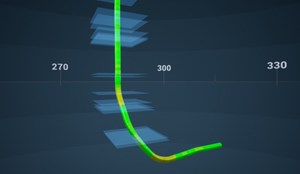
This additive is capable of forming a low permeable filter cake on the wellbore while circulating during drilling. The solution effectively bridged the microfractures as they were encountered without the need to halt drilling operations or make adjustments to the mud weight or employ other remediation actions. The correct concentration of the nanoparticle additive was carefully maintained at an optimal dosage throughout the drilling process, ensuring proactive prevention of mud loss. Continuous monitoring of the concentration was undertaken to ensure its efficacy and adherence to the desired outcome.
By leveraging the power of data analytics, the operator was able to draw valuable insights from historical drilling data and utilize it to refine the drilling process. In this case, machine learning algorithms were implemented to predict the optimal dosage and maintenance frequency of the nano particle additives when drilling new wells.
Leveraging historical data, the algorithms recommended an initial amount of 11,023 pounds (lb) of nano particles to be added into the active mud, resulting in a total concentration of 2% for maximum effectiveness. Throughout the drilling process within the trouble zone, the digital twin system closely monitored the entire operation, providing timely notifications for maintenance dosage of 850 lb for every 300 ft drilled. Additionally, critical drilling parameters were displayed, and the trajectory of the well was visualized, facilitating real-time monitoring and operational control.
To gather the necessary inputs for machine learning algorithms and accurately predict the optimal dosage and maintenance frequency of nano particle additives, the operator employs advanced smart equipment capable of monitoring crucial properties of the drilling mud. This intelligent technology enables real-time monitoring and data collection of key parameters including density, viscosity, temperature and the presence of various chemicals and contaminants. In contrast, traditional methods of monitoring and controlling drilling fluid properties relied on manual approaches such as visual inspection, laboratory testing and manual adjustments, which are known to have certain limitations.
Applying automated technologies. While manual methods can yield satisfactory results, they are generally less precise and accurate compared to the automated sensors utilized by smart equipment, Fig. 3. Moreover, manual methods tend to be time-consuming and labor-intensive and lacks the capability to provide real-time data.
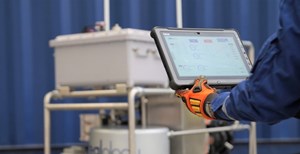
Another significant advantage of employing smart equipment is the reduction in the risk of human error. Automated sensors eliminate the potential for inaccuracies caused by human factors, ensuring more precise and reliable data input. The reliability of data input is essential for machine learning algorithms and hydraulic model calculations, enabling these advanced technologies to generate accurate calculations and predictions and optimize drilling operations.
By establishing a comprehensive digital ecosystem encompassing real-time data, historical data, data analytics, smart equipment, and digital twin technology, the operator achieves the capability to navigate through the challenging trouble zone while mitigating the risks associated with mud loss. As a result, they have successfully reduced potential risks and NPT by 15-20%, as documented by statistical analysis. This substantial improvement translates into substantial cost savings, amounting to approximately $350,000 per well in terms of reduced mud loss and associated expenses. In addition to cost savings and optimizing physical assets, digital twin technology offers various advantages that enhance communication efficiency and collaboration among personnel involved in drilling operations.
Visual representation. One notable benefit is the elimination of miscommunication and confusion arising from individuals having different mental images of the drilling process, Fig. 4. In the past, drilling engineers relied on diverse software and job logs to monitor and manage drilling operations, resulting in inconsistencies in the visual depiction of the process. However, with digital twin technology a unified and accurate representation of the drilling operations can be achieved enabling clearer communication and a shared understanding among team members.
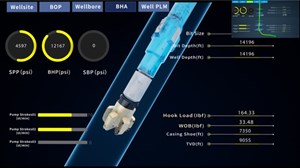
Digital twin technology effectively addresses this challenge by establishing a "unified" language that facilitates communication among all stakeholders. By offering a consistent visual representation of the drilling operation backed by real-time and precise data, it ensures that all parties involved share the same image. This alignment leads to enhanced communication, improved collaboration, and more informed decision-making. In this case study, the operator reported a 12% to 17% reduction in communication related errors and downtime.
Furthermore, digital twin technology can be integrated with virtual reality, mixed reality technology to create a virtual environment for visualization, training and off-location support purposes, Fig. 5. The virtual environment is continuously updated to reflect real-world changes, providing an up-to-date view of the drilling operations. This allows for off-location training programs where trainees can experience the entire process in a virtual world, without the risks, costs and logistical difficulties of an actual field operation.
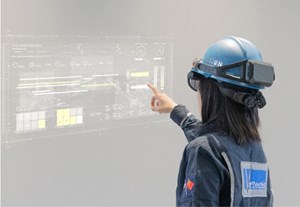
VALUE DELIVERED
The implementation of data analytics, smart equipment and digital twin technology presented in this case study highlights the potential for optimizing drilling operations and mitigating risks, helping the operator successfully overcame the challenges posed by a troublesome formation, minimizing mud loss and enhancing overall operational efficiency.
The integration of digital twin technology with virtual reality and mixed reality further enables immersive visualization, training and off-location support offering a safer and cost-effective alternative to traditional field operations.
These advancements led to a decrease in NPT, improved the decision-making processes resulting in substantial cost savings. The positive results document the transformative impact of these technologies while paving a path towards more efficient and sustainable drilling practices.
- Coiled tubing drilling’s role in the energy transition (March 2024)
- Digital transformation/Late-life optimization: Harnessing data-driven strategies for late-life optimization (March 2024)
- The reserves replacement dilemma: Can intelligent digital technologies fill the supply gap? (March 2024)
- Digital tool kit enhances real-time decision-making to improve drilling efficiency and performance (February 2024)
- E&P outside the U.S. maintains a disciplined pace (February 2024)
- U.S. operators reduce activity as crude prices plunge (February 2024)
- Applying ultra-deep LWD resistivity technology successfully in a SAGD operation (May 2019)
- Adoption of wireless intelligent completions advances (May 2019)
- Majors double down as takeaway crunch eases (April 2019)
- What’s new in well logging and formation evaluation (April 2019)
- Qualification of a 20,000-psi subsea BOP: A collaborative approach (February 2019)
- ConocoPhillips’ Greg Leveille sees rapid trajectory of technical advancement continuing (February 2019)


